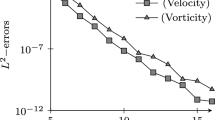Abstract
In this work, we focus our attention in the Stokes flow with nonhomogeneous source terms, formulated in dual mixed form. For the sake of completeness, we begin recalling the corresponding well-posedness at continuous and discrete levels. After that, and with the help of a kind of a quasi-Helmholtz decomposition of functions in H(div), we develop a residual type a posteriori error analysis, deducing an estimator that is reliable and locally efficient. Finally, we provide numerical experiments, which confirm our theoretical results on the a posteriori error estimator and illustrate the performance of the corresponding adaptive algorithm, supporting its use in practice.
Similar content being viewed by others
References
Agmon, S.: Lectures on elliptic boundary value problems. Van Nostrand Mathematical Studies, No. 2. D. Van Nostrand Co. Inc., Princeton, N.J.-Toronto-London, 1965. Prepared for publication by B. Frank Jones, Jr. with the assistance of George W. Batten, Jr. (1965)
Arnold, D.N.: An interior penalty finite element method with discontinuous elements. SIAM J. Numer. Anal. 19(4), 742–760 (1982)
Barrios, T.P., Behrens, E.M., Bustinza, R.: A stabilized mixed method applied to Stokes system with nonhomogeneous source terms: the stationary case. Dedicated to Prof. R. Rodríguez, on the occasion of his 65th birthday. Internat. J. Numer. Methods Fluids 92(6), 509–527 (2020)
Barrios, T.P., Behrens, E.M., González, M.: Low cost a posteriori error estimators for an augmented mixed FEM in linear elasticity. Appl. Numer Math. 84, 46–65 (2014)
Barrios, T.P., Bustinza, R., Campos, C.: A note on a posteriori error estimate for dual mixed method. Departamento de Ingeniería Matemática. Universidad de Concepción, Chile, Pre-print 2020-08 (2020)
Barrios, T.P., Bustinza, R., García, G.C., González, M.: An a posteriori error analysis of a velocity-pseudostress formulation of the generalized Stokes problem. J. Comput. Appl. Math. 357, 349–365 (2019)
Barrios, T.P., Bustinza, R., García, G.C., Hernández, E.: On stabilized mixed methods for generalized Stokes problem based on the velocity-pseudostress formulation: a priori error estimates. Comput. Methods Appl. Mech. Engrg. 237–240, 78–87 (2012)
Brezzi, F., Fortin, M.: Mixed and Hybrid Finite Element Methods, Volume 15 of Springer Series in Computational Mathematics. Springer, New York (1991)
Cai, Z., Lee, B., Wang, P.: Least-squares methods for incompressible Newtonian fluid flow: linear stationary problems. SIAM J. Numer. Anal. 42(2), 843–859 (2004)
Cai, Z., Tong, C., Vassilevski, P.S., Wang, C.: Mixed finite element methods for incompressible flow: stationary Stokes equations. Numer. Methods Partial Differ. Equ. 26(4), 957–978 (2010)
Carstensen, C., Bartels, S., Jansche, S.: A posteriori error estimates for nonconforming finite element methods. Numer. Math. 92(2), 233–256 (2002)
Carstensen, C., Kim, D., Park, E.-J.: A priori and a posteriori pseudostress-velocity mixed finite element error analysis for the Stokes problem. SIAM J. Numer. Anal. 49(6), 2501–2523 (2011)
Ciarlet, P.G.: The finite element method for elliptic problems, volume 40 of Classics in Applied Mathematics. Society for Industrial and Applied Mathematics (SIAM), Philadelphia. Reprint of the 1978 original [North-Holland, Amsterdam; MR0520174 (58 #25001)] (2002)
Clément, P.: Approximation by finite element functions using local regularization. Rev. Française Automat. Informat. Recherche Opér. Sér. 9(R-2), 77–84 (1975)
Durán, R., Gastaldi, L., Lombardi, A.: Analysis of finite element approximations of S,tokes equations with nonsmooth data. SIAM J. Numer Anal. 58(6), 3309–3331 (2020)
Farhloul, M., Fortin, M.: A new mixed finite element for the Stokes and elasticity problems. SIAM J. Numer. Anal. 30(4), 971–990 (1993)
Farhloul, M., Nicaise, S., Paquet, L.: A posteriori error estimation for the dual mixed finite element method of the Stokes problem. Numer. Funct. Anal Optim. 27(7-8), 831–846 (2006)
Figueroa, L.E., Gatica, G.N., Márquez, A.: Augmented mixed finite element methods for the stationary Stokes equations. SIAM J. Sci. Comput. 31(2):1082–1119 (2008/09)
Gatica, G.N., Márquez, A., Sánchez, M.A.: Analysis of a velocity-pressure-pseudostress formulation for the stationary Stokes equations. Comput. Methods Appl. Mech Eng. 199(17-20), 1064–1079 (2010)
Gatica, G.N., Márquez, A., Sánchez, M.A.: A priori and a posteriori error analyses of a velocity-pseudostress formulation for a class of quasi-Newtonian Stokes flows. Comput. Methods Appl. Mech. Engrg. 200(17-20), 1619–1636 (2011)
Girault, V., Raviart, P.-A.: Finite Element Methods for Navier-Stokes Equations, Volume 5 of Springer Series in Computational Mathematics. Springer, Berlin. Theory and algorithms (1986)
Hiptmair, R.: Finite elements in computational electromagnetism. Acta Numer. 11, 237–339 (2002)
Kovasznay, L.I.G.: Laminar flow behind two-dimensional grid. Proc. Cambridge Philos. Soc. 44, 58–62 (1948)
Roberts, J.E., Thomas, J.-M.: Mixed and hybrid methods. In Handbook of numerical analysis, Vol. II, Handb. Numer. Anal., II, pp. 523–639. North-Holland (1991)
Verfürth, R.: A posteriori error estimation and adaptive mesh-refinement techniques. In: Proceedings of the F,ifth International Congress on Computational and Applied Mathematics (Leuven, 1992), vol. 50, pp. 67–83 (1994)
Verfürth, R.: A Review of a Posteriori Error Estimation and Adaptive Mesh-Refinement Techniques. Advances in Numerical Mathematics. Wiley-Teubner, Chichester (1996)
Funding
This research has been partially supported by ANID-Chile through the project Centro de Modelamiento Matemático (AFB170001) of the PIA Program: Concurso Apoyo a Centros Científicos y Tecnológicos de Excelencia con Financiamiento Basal CONICYT-Chile and by FONDECYT Grant 1200051; by Centro de Investigación en Ingeniería Matemática (CI2MA), Universidad de Concepción (Chile), and by Dirección de Investigación de la Universidad Católica de la Santísima Concepción (Chile), through Incentivo Mensual program.
Author information
Authors and Affiliations
Contributions
All authors have contributed equally in this article.
Corresponding author
Additional information
Communicated by: Paul Houston
Publisher’s note
Springer Nature remains neutral with regard to jurisdictional claims in published maps and institutional affiliations.
Rights and permissions
About this article
Cite this article
Barrios, T.P., Behrens, E.M. & Bustinza, R. An a posteriori error estimate for a dual mixed method applied to Stokes system with non-null source terms. Adv Comput Math 47, 77 (2021). https://doi.org/10.1007/s10444-021-09906-2
Received:
Accepted:
Published:
DOI: https://doi.org/10.1007/s10444-021-09906-2



